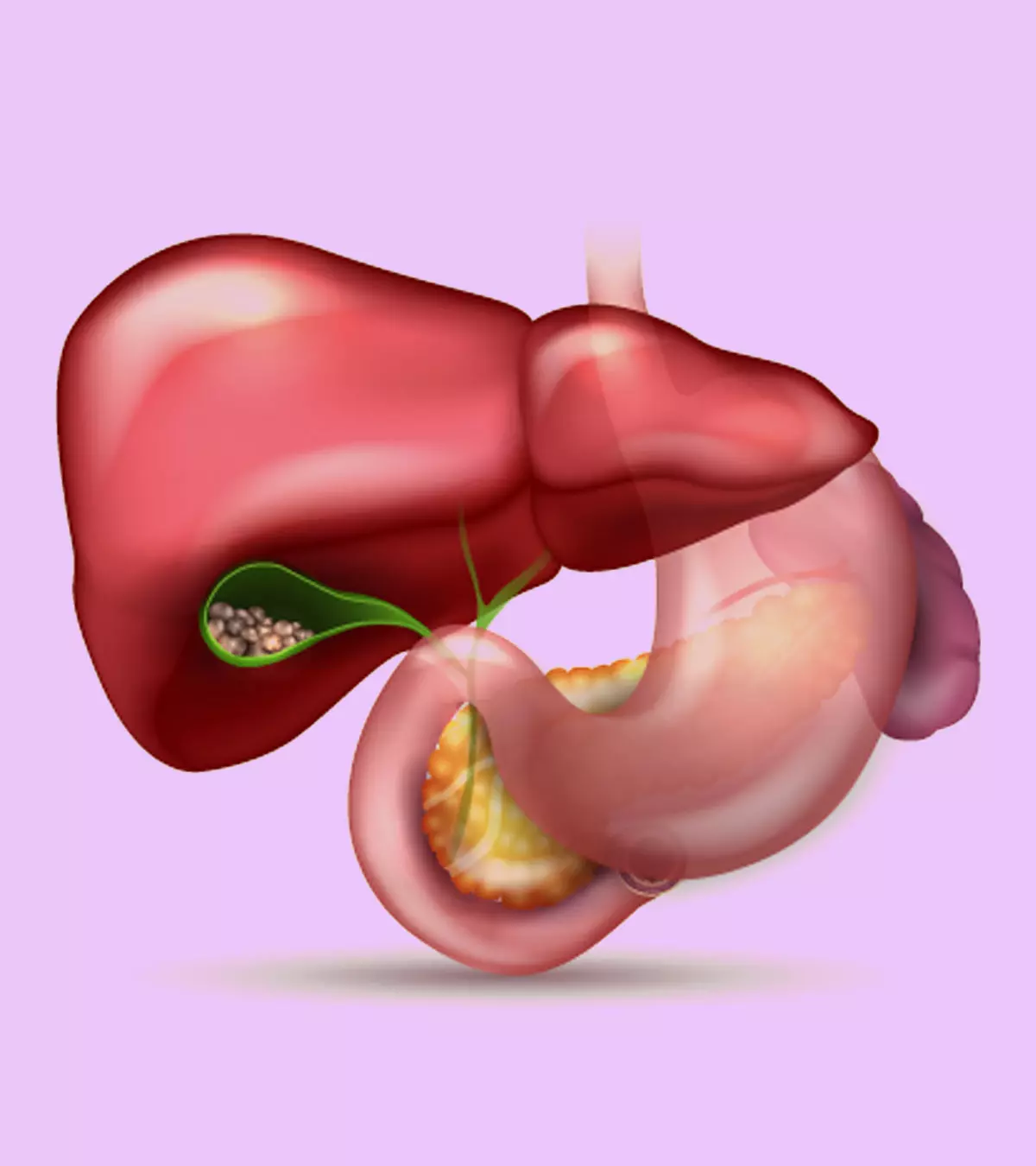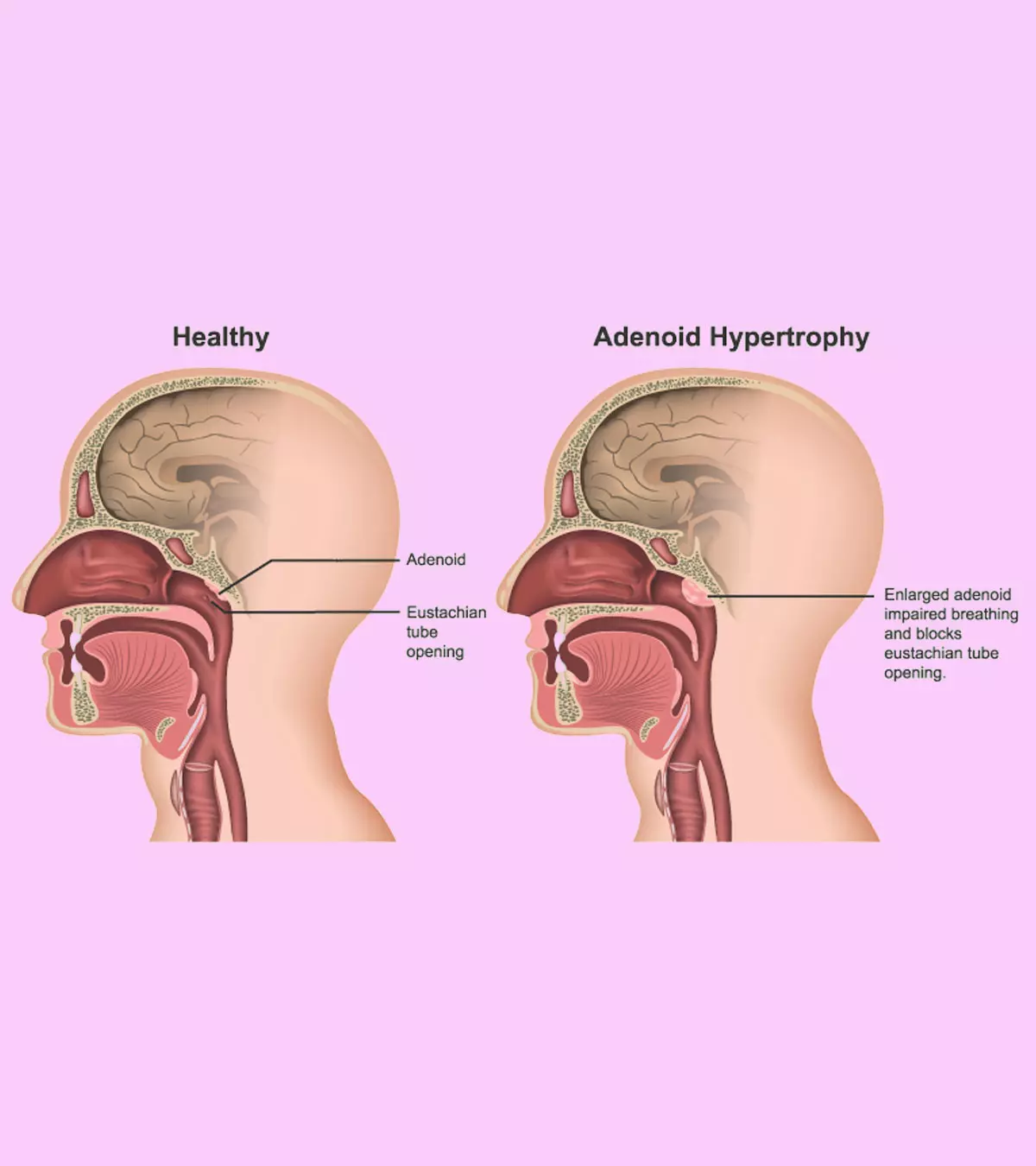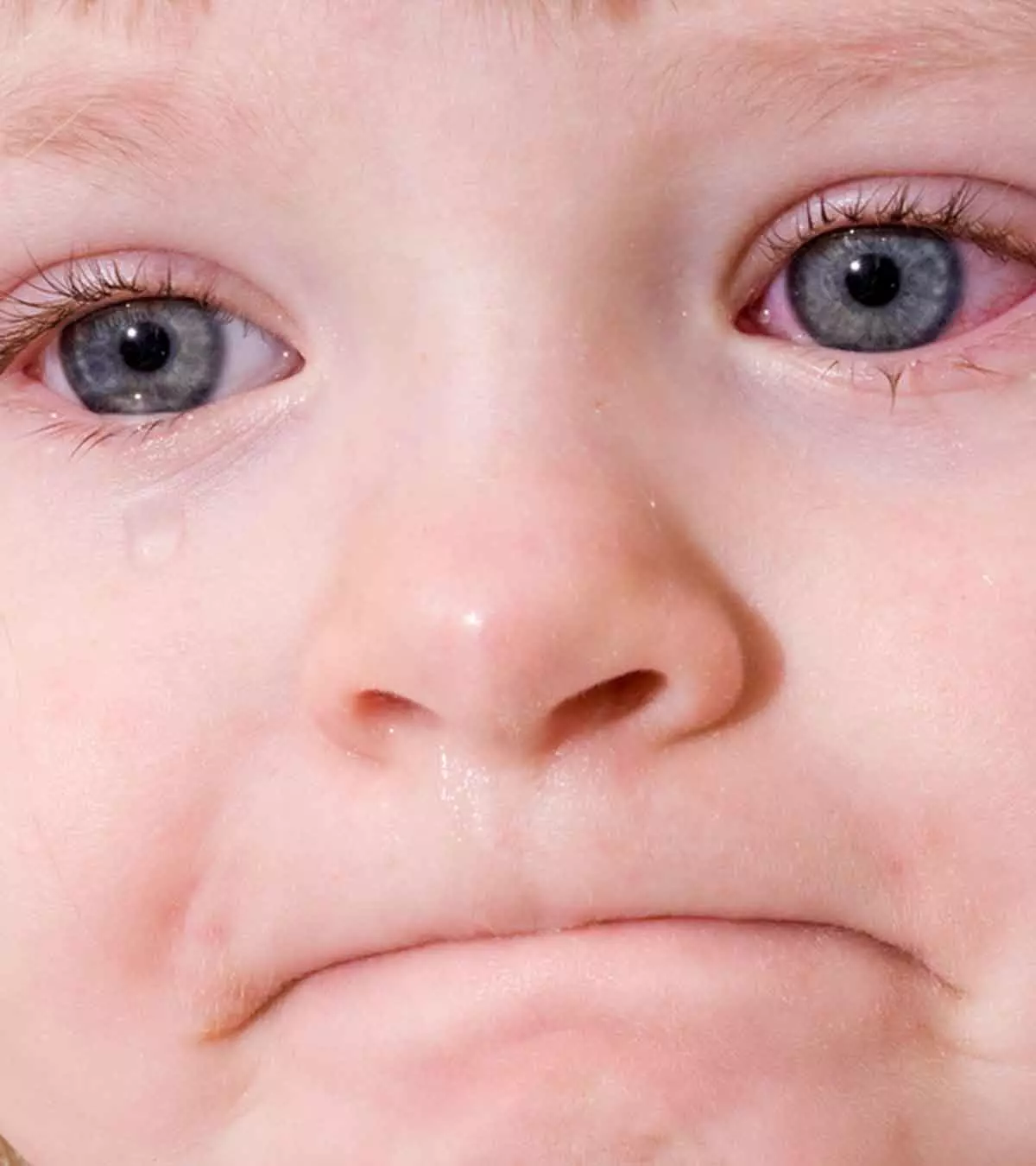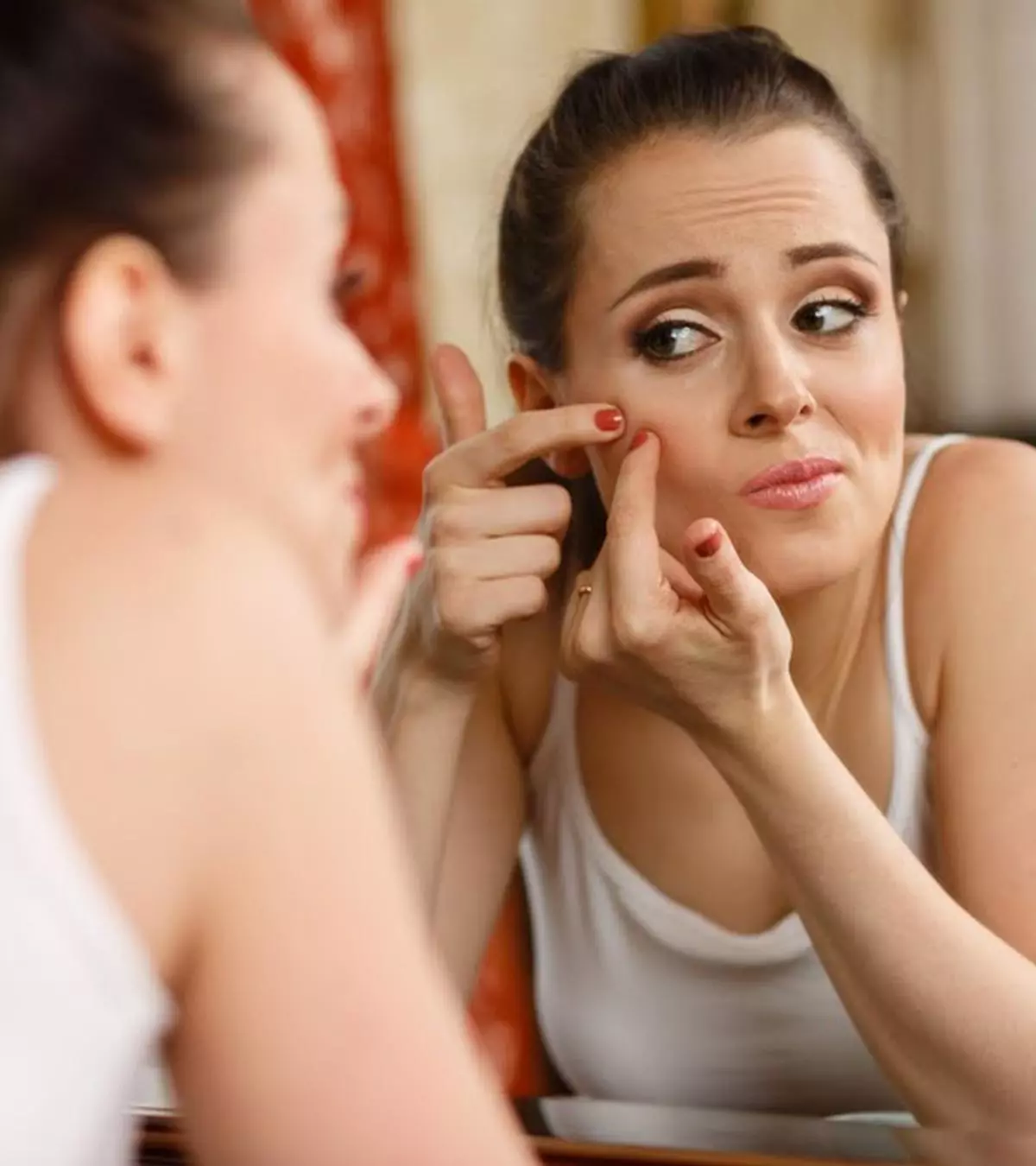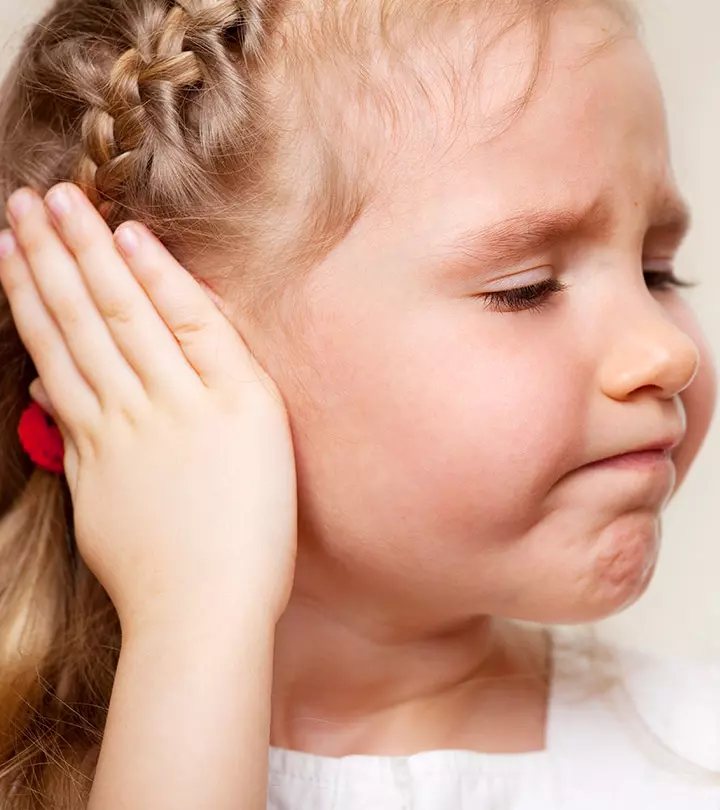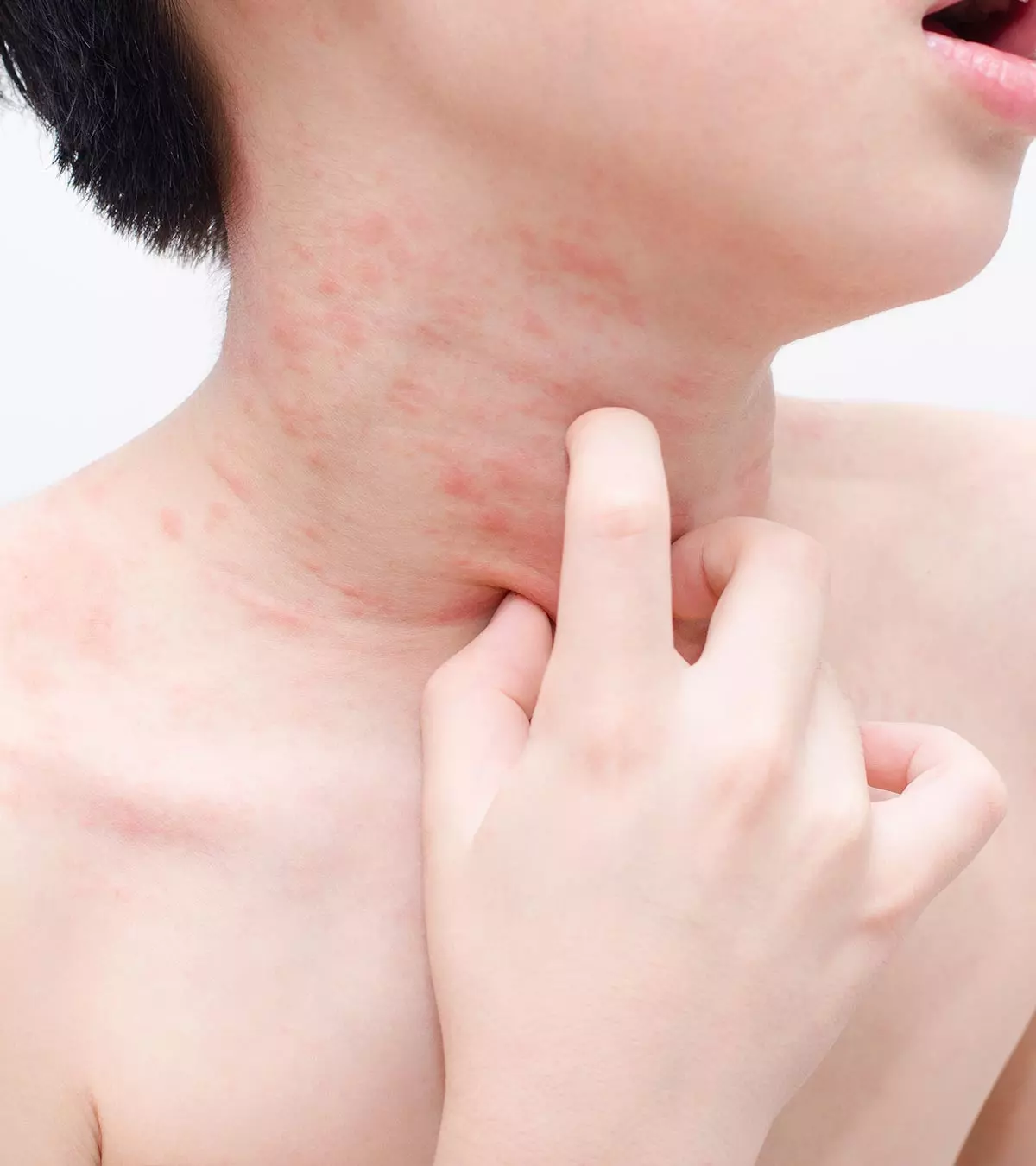
Image: Midjourney/ MomJunction Design Team
Noticing fine lines and wrinkles on your face at a young age can be disappointing, but it isn’t abnormal. Teenage wrinkles can occur due to several manageable causes, such as stress, erratic diet, hormonal changes, and physical stresses. Determining the cause and making appropriate lifestyle changes address the problem for most teens. Over-the-counter cosmetic products such as wrinkle creams could also help, and the need for any elaborate cosmetic treatment is rare.

Teenage wrinkles may impact your child’s self-esteem and body image. Thus, it’s important to address these concerns early and encourage good skin care habits. Keep reading to know about the possible causes, home remedies, treatments, and preventive steps for wrinkles in teenagers.
Key Pointers
- Wrinkles are uncommon for teenagers since their skin has enough elasticity and collagen during their teenage years.
- Teenagers may develop wrinkles due to excessive exposure to sunlight, smoke, pollution, and stress.
- Doing a face massage and applying honey and aloe vera may reduce wrinkles.
- The dermatologist may suggest hyaluronic acid-based serums, lotions, or other cosmetic treatments.
- Practicing good habits, such as eating a balanced diet and good sleep, may prevent wrinkles in teenagers.
Are Wrinkles Normal For Teenagers?

It is usually uncommon for youth to develop deep wrinkles or even fine lines. The dermis, the middle layer of the skin, contains fibers called elastin and a protein called collagen (1). Adequate elastin and collagen are responsible for smooth, supple, and wrinkle-free skin. The dermis loses these substances as it ages, and that is why we develop wrinkles as we grow older. However, there is sufficient elastin and collagen in the skin during the teenage years, and teenage wrinkles are uncommon during this phase.
The premature appearance of wrinkles in teenagers could be due to numerous factors, such as exposure to sunlight, pollution, stress, dry skin, and even facial expressions.
Causes Of Teenage Wrinkles
The following situations and lifestyle choices could lead to wrinkles in teenagers.
1. Prolonged exposure to sunlight
Prolonged exposure to the sun’s UV rays is usually the most common cause of premature wrinkles (2). Teens who neglect wearing sunscreen while outdoors under direct sunlight could be at an increased risk of developing premature wrinkles.
Professionals from four different children’s hospitals in the United States conducted a cross-sectional survey on perceived sun exposure and protective behaviors. The data reveals that the use of sunscreen among teenagers declined as they aged and varied significantly between males and females. Analysis of gender-based responses shows that only around 28% of males used sunscreen, while 42% of females considered themselves vulnerable to sunburn and utilized sunscreen.
The harmful UV rays of the sun create free radicalsiUnstable molecules that can cause damage to other molecules, such as lipids and proteins. in the skin. These free radicals impair the elastin fibers in the skin, leading to wrinkles. The use of UV tanning beds could also lead to similar effects (3). Dr. Michele S. Green, a board-certified cosmetic dermatologist from New York, says, “Prolonged exposure to sun and tanning beds accelerates the formation of premature fine lines and wrinkles and increases the risk of skin cancer.”
2. Eating excess sugar
Studies indicate that consuming excess sugar could hasten the skin’s aging process (4).
In our body, sugar undergoes glycation, a chemical reaction between free sugar and proteins or lipids. This affects protein function, weakening the skin’s elasticity and resulting in wrinkles and other signs of premature skin agingiSkin appears older than the actual age of the individual. (5).
3. Excessive stress
Teens may experience stress due to several experiences related to school or peer pressure. Extreme or constant stress increases the levels of cortisol, a hormone released by the adrenal glandsiAlso known as suprarenal glands, they are a pair of small, triangular-shaped organs that are present on top of each kidney. when the body experiences stress (6). The hormone is noted to increase all signs of premature aging in the body, including the development of premature skin wrinkles.
 Expert says
Expert says4. Sleep deprivation
Studies have found that inadequate sleep could affect immune function, which could impact collagen production (7). Sleep deprivation could affect the body’s ability to repair damaged collagen molecules. Insufficient collagen could impact the skin’s integrity, leading to premature aging.
Sleep deprivation could also increase cortisol levels, leading to premature wrinkles in teenagers (6).
5. Smoking or exposure to smoke
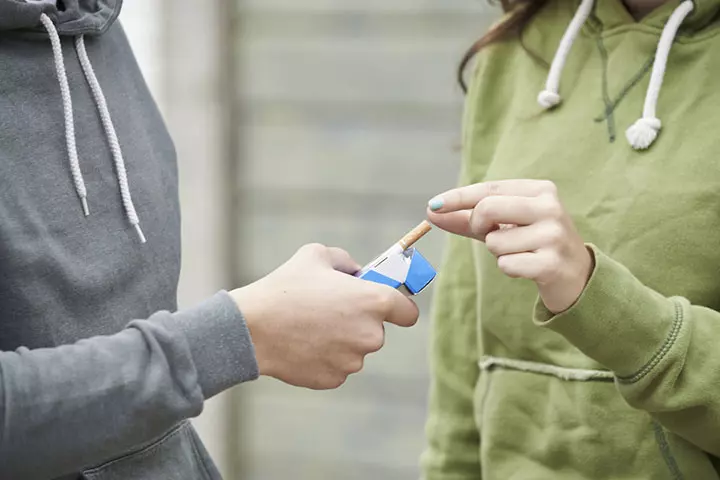
Tobacco smoke can affect all parts of the body, including the skin. The compounds found in tobacco smoke could accelerate signs of skin aging, such as wrinkles, by impeding the production of collagen (8). Tobacco smoke compounds could also degrade collagen. The degradation of existing collagen and impaired production of new collagen ultimately leads to premature teenage wrinkles.
The nicotine found in tobacco smoke could constrict blood vessels, preventing adequate oxygen from reaching all skin layers (9). The vasoconstriction of blood vessels can damage elastin, causing the skin to become loose and increasing the risk of developing wrinkles. Smoking a cigarette involves pursing of lips that can also cause wrinkles around the mouth.
6. Repetitive facial expressions
Repetitive facial movements and expressions, such as squinting, raising eyebrows, and pursing lips, could cause recurrent contraction of the underlying muscles. It could cause skin creases, which in the long run may become wrinkles (10).
7. Exposure to pollution
Pollutant particulate matter in the air could cause oxidative stressiOccurs when there are more free radicals than antioxidants in the body. , which causes signs of skin aging, such as premature wrinkles (11). Air pollutants can damage elastin and collagen, increasing the risk of wrinkles. Some particulate matter may penetrate the skin via hair follicles, further increasing the premature damage to the skin (12).
 Quick fact
Quick fact8. Dry skin
The lack of adequate moisture could cause the skin cells to shrivel, increasing the appearance of lines and wrinkles (13). Dry skin may also work as a poor barrier against other factors, such as pollutants, leading to premature aging (14).
9. Low water intake
Insufficient water intake could cause inadequate water to reach the skin cells (15). It could eventually cause the skin to become dry and flaky, making it more susceptible to wrinkles (16).
10. Alcohol and drug abuse
Alcohol causes dryness because it is a diureticiSubstance that causes an increase in urine production. . It dehydrates various organs of the body, including the skin. The loss of skin moisture due to excess alcohol consumption could lead to wrinkles (10).
The use of narcotics is known to exacerbate skin aging in general (17). The compounds found in hallucinogensiDrugs that change a person’s perception of reality. may damage elastin and collagen while also affecting the skin’s moisture content. Teens who abuse drugs could ultimately be more prone to wrinkles.
Beyond these causes, the use of some medications may lead to wrinkles in some teenagers (18).
Genetics may play a role, and teens may develop wrinkles if their parents had teenage wrinkles or experienced premature aging. Easton Dermatology Associates states that genetic makeup determines the skin’s appearance and the amount of collagen and elastin produced. Therefore, parents who had wrinkles earlier in their lives may pass this genetic trait to their children (28). However, more research is needed to prove it. Certain genetic disorders, such as progeriaiA rare condition wherein children age prematurely (Hutchinson-Gilford syndrome), cause premature wrinkles (29); however, these are pathological reasons and different from lifestyle-related causes, which are more common causes for wrinkles among teens with no underlying disorders.
Home Remedies For Wrinkles In Teenagers
According to Courtney Keener, Associate Clinical Director at Camber Children’s Mental Health in Hays, Kansas City, “Teens are at that age where they naturally have lower self-esteem because their body is changing, their hormones are changing and they’re learning about themselves” (30). Therefore, any changes in their appearance need to be addressed. The following home remedies may reduce teenage wrinkles and gradually eliminate them. If your adolescent has sensitive skin, allergies, or other skin conditions, consult a dermatologist before adding home remedies to their skincare routine.
1. Do face massage
Massaging is one of the most effective skin care tips for teens that can help keep their skin healthy and promote muscle relaxation. Talking about the benefits of face massage, Vickie Bodner, LMT, RM, CS, and a Licensed Massage Therapist at Cleveland Clinic says, “Anytime you bring blood flow into an area, it gets your capillaries (blood vessels) moving, which can promote a relaxation of the muscles and get fluids moving” (31).
Use oil to massage the face with deep and stimulating circular motions. If your teen has sensitive skin that is susceptible to breakouts, ask them to use light pressure. They must massage their face daily to reduce wrinkles.
2. Apply honey
Honey contains several antioxidants that may neutralize the free radicals responsible for premature skin aging (32). It also contains compounds that may help clear dead skin cells, reduce fine lines, and eliminate light wrinkles. For best results, apply raw honey over the face and neck and keep it for 20-30 minutes. Wash the face with lukewarm water. You can also combine honey with milk, yogurt, green apple, or banana for better results. Mixing honey with the mentioned ingredients can help make a great homemade face mask for teenagers.
3. Use aloe vera
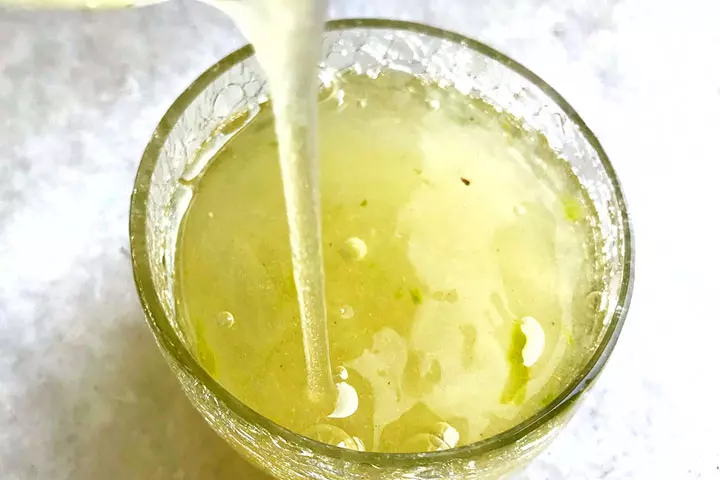
Aloe vera gel may enhance collagen production, improve skin elasticity, and promote skin tightening. According to the WHO, Aloe vera gel stimulates fibroblast activity, which increases collagen and proteoglycan synthesis and promotes tissue repair (33). Aloe vera also contains several vitamins that may help repel free radicals responsible for wrinkles and improve child’s skin health. Massage your face with aloe vera gel so that it penetrates the skin pores. Leave it for 15 minutes and then rinse it off with lukewarm water. Do this daily for wrinkle-free skin.
4. Use egg white mask
Egg white is rich in micronutrients and proteins that may help fight off free radicals and prevent wrinkles. You may make this mask by separating egg whites from the yolk and whisking it. Apply it on the face with a brush and leave it for 15 to 20 minutes. Wash it off with lukewarm water. Make sure you buy organic eggs from a trusted source since raw eggs may sometimes contain pathogens, such as salmonella bacteria (19).
5. Apply an oatmeal mask
Regular use of an oatmeal mask may reduce the appearance of wrinkles and improve skin elasticity. Scientific studies demonstrate that beta-glucan present in oats deeply penetrates the skin, reaching the dermis and stimulating collagen synthesis through immune cell activation (20). Additionally, amino acids present in oats may promote skin health and collagen formation. To create a simple oat mask, mix whole rolled oats with milk until you get a smooth paste. Apply this paste to a cleansed face and neck. Leave it for 20 minutes, and rinse off with lukewarm water. Alternatively, you may try other combinations like oats with turmeric, apple, or almond oil to find what works best for reducing wrinkles.
6. Apply creams with vitamin C
Vitamin C is an antioxidant that could fight off free radicals and play a vital role in the synthesis of collagen (21). The use of face creams rich in vitamin C may help improve collagen production, reducing the appearance of wrinkles eventually. The adolescent may consider applying a night cream before bedtime. Wash the face with lukewarm water and apply the cream as per instructions on the container.
 Quick fact
Quick factMost home remedies are backed by little scientific evidence. Therefore, it is ideal to consult a dermatologist before trying them out. You may also consult a dermatologist if you wish to explore treatments for teenage wrinkles.
Treatments For Wrinkles In Teens
A dermatologist will assess several factors, such as the teen’s age, health condition, the underlying cause of teenage wrinkles, lifestyle, and overall skin health, before determining a suitable treatment method. If treatment is considered, the dermatologist may recommend any of the following procedures.
1. Topical treatment
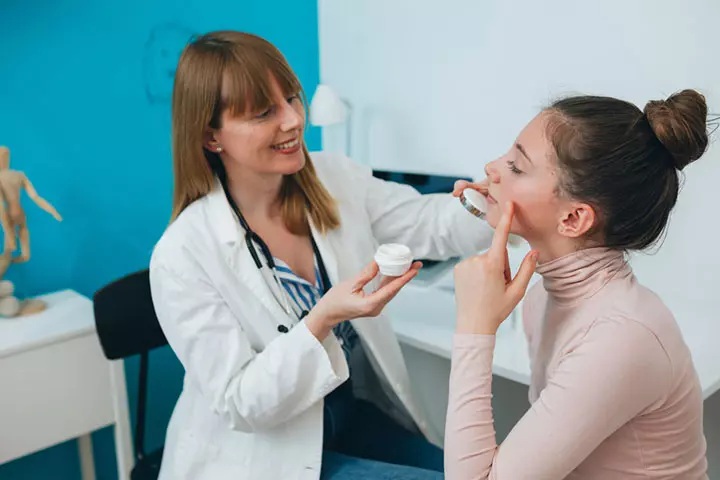
It could be the preferred treatment modality to eliminate teenage wrinkles. Topical treatment may include the use of serums and creams that aim at eliminating wrinkles over time. A few examples include hyaluronic acidiMolecule that binds water to the skin and hydrates it. -based serums and creams with vitamin C or retinoliA form of Vitamin A that promotes acne treatment and anti-ageing effects. .
Hyaluronic acid may help improve the elasticity of the epidermis, the top layer of skin. It may help reduce wrinkles by keeping the skin plump and smooth. Creams with vitamin C or retinol (vitamin A) could reduce free radical damage and improve collagen synthesis.
Many of these creams are available over-the-counter, but they are best used as per the doctor’s prescription.
Dr. Green adds, “Generally, dermatologists recommend the gold-standard anti-aging ingredient, retinol, to begin in the early 20s, but it may be beneficial for teenagers to start preventative measures. In-office treatments like BotoxiA drug or a toxin, made by the bacterium Clostridium botulinum that helps to smooth face wrinkles by restricting muscle movement for a limited time. are not recommended for patients younger than 18, with most experts recommending Botox treatments in the mid to late 20s and early 30s for preventative measures.”
2. Cosmetic treatment
Cosmetic procedures could include non-invasive procedures that can help reduce teenage wrinkles through external interventions, such as ablative tools or chemicals.
Cosmetic treatment is usually not recommended for teens due to the procedures’ potential to cause severe side effects and the risk of permanent skin damage. Most teens may not show wrinkles significant enough to qualify for these procedures in the first place. Also, there might be legal limitations and implications related to cosmetic surgery of teens, depending on your resident country or state (22). According to the American Academy of Pediatrics (AAP), no US laws restrict teens’ cosmetic procedures; however, parental consent is necessary for patients under 18 years of age (34).
If you wish your teen to have a cosmetic treatment for wrinkles, discuss the procedure and its prognosis in detail with your teen and a dermatologist or plastic surgeon specializing in the cosmetic surgery of teens. Also, have your teen initiate the request for surgery. Below are some cosmetic treatments that may be considered for teenage wrinkles (23) (24) (25).
- Laser resurfacing: It involves the use of a laser beam to carefully ablate unwanted imperfections, such as wrinkles, from the skin.
- Dermabrasion: The doctor uses an abrasive tool to sand your skin in a controlled manner. It helps eliminate the imperfect, dry outer layer of skin, rendering a smooth appearance to the skin.
- Chemical peel: A chemical peel involves using chemicals to peel the flawed outer layers of the skin, giving it a smoother appearance.
- Photodynamic therapy: It is a type of photochemical process where light of a specific frequency is used along with a chemical to improve the skin’s appearance.
- Micro needling: The procedure involves pricking the skin with pen-shaped or roller devices. The injury caused by these pricks stimulates collagen production, reducing wrinkles eventually.
Invasive procedures used in adults, such as botox, facelift, and fillers, are not recommended for teenagers.
Prevention Of Wrinkles In Teenagers
Avoiding the various potential causes of wrinkles is the best way to prevent teenage wrinkles. The following skincare tips can be helpful to keep their skin healthy and wrinkle-free.
- Protect skin from sunlight: Ask your teen to apply a broad-spectrum sunscreen with an SPF of 30 or more whenever they step out in the sun. They must reapply it every couple of hours if they intend to stay outdoors for long, are swimming, or tend to sweat a lot. Wearing a long-sleeved shirt, pants, UV protection sunglasses, and a big-brimmed hat could also minimize skin exposure to sun rays.
- Eat a healthy balanced diet: Eat a balanced meal with adequate fruits and vegetables. Incorporate a good amount of vitamins A, C, and E in your diet as they are good for your skin. Reduce the consumption of sugar and carbs. Drink at least eight glasses of water daily.
- Practice meditation and exercise: Practicing yoga and meditation regularly helps in relieving stress and refreshes the body. Working out regularly also helps reduce the levels of cortisol, the stress hormone. Stress-relieving hormones, such as endorphins, are also released and they help elevate your mood. These interventions could reduce wrinkles and improve the overall appearance of the skin.

- Improve sleeping habits: Getting enough sleep can improve the body’s ability to repair itself. It can even enhance collagen synthesis and reduce the appearance of wrinkles. Adequate sleep also reduces the levels of cortisol; thus, contributing to healthier skin. Experts recommend that teens get nine to ten hours of sleep each night for healthy growth (26).
- Protect against pollutants: The dirt, pollutants, and sweat that clings to the skin could cause premature aging. Rinsing the face gently, without scrubbing it, twice a day, can be helpful. A teen may use a mild cleanser designed to remove pollutants stuck to the skin. Avoiding places with excessive pollution and wearing face protection, whenever possible, could help protect the skin from pollutants.
- Quit unhealthy habits: If your teen smokes, uses narcotics, or consumes alcohol, help and encourage them to quit the habit. You may contact a local support group to learn ways of helping your teen quit the habit. Speak to your pediatrician, who may teach you ways to assist youth in their efforts to quit unhealthy habits. Remember, teens learn from their parents. Make sure you quit any habits yourself before expecting them to do the same.
Dr. Ivona Percec, MD, PhD, and a physician at Penn Plastic Surgery, Philadelphia, states, “Keep in mind: Some of the least expensive ways to fight aging involve no creams whatsoever. For instance, getting more sleep, hydrating, and avoiding sun exposure can prevent signs of aging. Also, certain ingredients in foods, such as vitamin C in tomatoes, may keep your skin healthy and prevent wrinkles” (35).
Frequently Asked Questions
1. Which muscle is responsible for horizontal wrinkles on my forehead?
The action of the frontalis muscle forms horizontal forehead wrinkles or lines. It can cause four types of forehead lines, including full straight lines covering the whole forehead, wing-shaped lines with a central depression, short lines, and lateral straight lines (27).
2. How should one get rid of deep forehead wrinkles?
If the lines are already present, you may seek help from a board-certified dermatologist to deal with forehead lines. You can benefit from less invasive procedures such as skin tightening. Lifestyle changes and protecting skin from the sun and other damages with adequate care measures can reduce the intensity of wrinkles on the forehead (10).
3. Can teenage wrinkles go away on their own?
Dr. Green opines, “If the fine lines and wrinkles are caused by dehydration, drinking plenty of water and applying a hydrating moisturizer can soften their appearance. Using retinol or Retin-A may also help diminish fine lines and wrinkles as they stimulate collagen synthesis and increase skin cell turnover. However, dynamic wrinkles caused by repetitive muscle movement (for example, furrowing and raising your eyebrows) likely will not go away on their own as the muscle movements break down collagen in the creases.”
Teenage wrinkles may appear for several reasons and are seldom a matter of serious concern. In most teens, early signs of wrinkles could result from stress and an unhealthy lifestyle. Therefore, lifestyle changes and stress management might help eliminate wrinkles and maintain youthful beauty. Also, it is important to check on the sugar intake, maintain good hydration levels, and quit smoking and alcohol consumption which may help reduce wrinkles. Nevertheless, get your teen evaluated by a dermatologist if their wrinkles seem to be increasing to determine the underlying issue and develop a suitable treatment intervention.
Infographic: Skin Care Tips To Prevent Premature Aging
The teenage years are supposed to be filled with fun trips and high school and college memories, and it is not the time to worry about wrinkles. Premature aging may not be too common, but it is preventable with some simple yet effective practices. So pin this infographic near your mirror and follow these tips for youthful skin.
Some thing wrong with infographic shortcode. please verify shortcode syntax
Illustration: Causes Of Wrinkles At Young Age And Tips To Prevent

Image: Dall·E/MomJunction Design Team
References
1. 5.1 Layers of the Skin; Oregon State University
2. Wrinkles; Victoria State Government
3. Wrinkles and other signs of sun-damaged skin can be treated; American Academy of Dermatology Association
4. H Pageon, Reaction of glycation and human skin: the effects on the skin and its components, reconstructed skin as a model; National Library of Medicine
5. Chan-Sik Kim, Sok Park, and Junghyun Kim, The role of glycation in the pathogenesis of aging and its prevention through herbal products and physical exercise; JENB; National Library of Medicine
6. Gray hair and wrinkles; Tufts Medical Center
7. V Kahan et al., Can poor sleep affect skin integrity?; National Library of Medicine
8. Akimichi Morita, Tobacco smoke causes premature skin aging; National Library of Medicine
9. Dr Susan Simpkin, Smoking and its effects on the skin; DermNet NZ
10. 11 Ways to reduce premature skin aging; American Academy of Dermatology Association
11. Eleni Drakaki and Clio Dessinioti, Air Pollution and the skin; ResearchGate
12. Andrea Vierkotter et al., Airborne Particle Exposure and Extrinsic Skin Aging; Journal of Investigative Dermatology
13. Wrinkles; Mayo Foundation for Medical Education and Research (MFMER)
14. Hideo Hashizume, Skin aging and dry skin; National Library of Medicine
15. The Benefits of Drinking Water for Your Skin; UW Health
16. Lidia Palma et al., Dietary water affects human skin hydration and biomechanics; National Library of Medicine
17. Nisha Raiker, Mouhammad Aouthmany and Navid Ezra, Dermatologic Signs and Symptoms of Substance Abuse; Journal of Clinical & Experimental Dermatology Research
18. The Sun, Skin and Aging; UC Davis Health
19. Salmonella and Eggs; FoodSafety.gov
20. Sarvajnamurthy Aradhya et al.,A Randomized, Assessor-Blinded, Comparative Study to Evaluate the Efficacy and Safety of Oat Extract-Based Moisturizer in Adult Individuals with Dry Skin; Clinical Dermatology Review
21. Vitamin C and Skin Health; Oregon State University
22. Derrick Diaz Minors, Minors and Cosmetic Surgery: An Argument for State Intervention; DePaul University
23. Rod Rohrich, When is plastic surgery appropriate for teenagers?; American Society of Plastic Surgeons
24. Wolfgang G Philipp-Dormston, Photodynamic therapy for aesthetic-cosmetic indications; National Library of Medicine
25. Rebecca Small, Botulinum Toxin Injection for Facial Wrinkles; American Academy of Family Physicians
26. Teenagers and Sleep: How Much Sleep Is Enough?; John Hopkins Medicine
27. Kenneth Pessino, et al; Anatomy, Head and Neck, Frontalis Muscle; National Library of Medicine
28. Are Wrinkles Hereditary?; Easton Dermatology Associates
29. Progeria; Cleveland Clinic
30. Supporting Teens in Navigating Body Image and Self-Esteem Challenges; KVC Health Systems
31. Can Exercising Your Face Help You Look Younger?; Cleveland ClinicT
32. Bruno Burlando and Laura Cornara; Honey in dermatology and skin care: a review; Journal of cosmetic dermatology; NCBI
33. WHO Monographs on Selected Medicinal Plants; World Health Organization
34. Cosmetic Surgery in Teens: Information for Parents; HealthyChildren.org
35. The Truth About Wrinkles: 5 Common Wrinkle Myths Debunked; PennMedicine
Community Experiences
Join the conversation and become a part of our nurturing community! Share your stories, experiences, and insights to connect with fellow parents.
Read full bio of Dr. Deepak Jakhar
- Dr. Michele S. Green is a board-certified dermatologist based in New York City specializing in cosmetic dermatology. A graduate of Yale University with an MD from Mount Sinai Medical School in NYC, she owns a private practice in Upper East Side
 Dr. Michele S. Green is a board-certified dermatologist based in New York City specializing in cosmetic dermatology. A graduate of Yale University with an MD from Mount Sinai Medical School in NYC, she owns a private practice in Upper East Side
Dr. Michele S. Green is a board-certified dermatologist based in New York City specializing in cosmetic dermatology. A graduate of Yale University with an MD from Mount Sinai Medical School in NYC, she owns a private practice in Upper East Side
Read full bio of Shivali Karande
Read full bio of Dr. Ritika Shah
Read full bio of Shinta Liz Sunny








